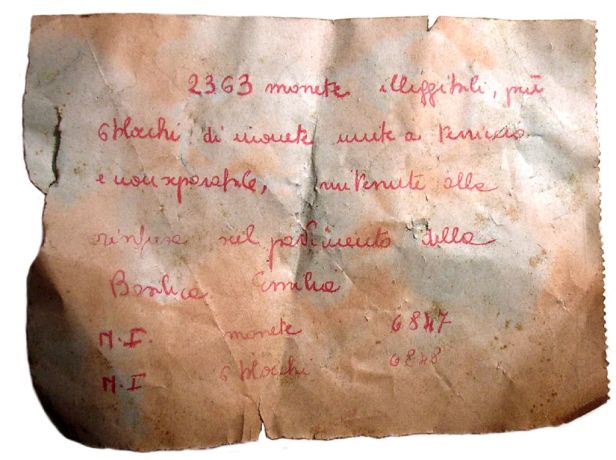ROMA ARCHEOLOGICA & RESTAURO ARCHITETTURA: Il Foro Romano – Giacomo Boni e il mistero delle monete scomparse in Basilica Aemilia | Coin Finds from the Basilica Aemilia (1899-1932). University of Warwick, U.K., (2014-2016) & BOSTON, U.S.A. 10 January (1912).
1). ROME – THE ROMAN FORUM | BASILICA AEMILIA: Coin Finds from the Basilica Aemilia, University of Warwick, U.K., (2014-2016).
Discovery and provenance of the coins
This project is dedicated to c. 2,600 coins found in the Basilica Aemilia on the Forum Romanum in Rome. The coins were found during the excavations conducted by the German Archaeological Institute from 1899 to the 1930ies. Unlike a lot of 467 other coins, they have never been studied and were forgotten until 2009 when they were rediscovered in a wooden box in the Antiquarium on the Forum (Antiquario Forense).
Most coins belong to the late antique destruction layer of the basilica. This stratum was 6 to 10 centimeters thick and consisted of ashes including lumps of coins. It covered the marble floor of the Augustan restauration, with many coins stuck melted on the floor. The original Basilica Aemilia is one of the big basilicae surrounding the central area of the Forum. Erected in 179 BC according to Livy (40.51.4–5) it belongs to a building program aiming to monumentalise that area from the late fourth century BC culminating with the construction of the aforementioned basilicae in the first half of the second century BC.
The archaeology of the coins and the history of Rome
The destruction of the building was related to the sac of Rome under the Visigoth king Alaric, in August AD 410, on the ground of a coin of Priscus Attalus of AD 409 identified among the 467 known coins. The date of AD 410 went indeed into the handbooks and, if correct, this would be one of the very rare examples of archaeological evidence attesting to the conflicts during the so-called barbarian migrations in Late Antiquity.
The functions of the building
Over the centuries the building had many functions, such as place for banking and for jurisdictional purposes. Traces of corroded and burnt metal on the marble floor point to moneychangers’ tables (trapezae) placed between the columns along the central nave. On the marble floor, in equal distances between the tables, engraved lines of board games were found. Because of their number and regular spread on the floor the Basilica Aemilia has also been identified as a gambling house.
Research questions
The recent discovery of the c. 2,600 multiplies the hitherto known number of coins. It is of extreme interest as a key to
• review and to refine the date of the destruction, especially with the coins found in conglomerated lumps of ash;
• better understand the nature of the building, especially in the context of banking;
• investigate the role of the mint of Rome;
• examine the coin circulation in Rome;
• assess the historical context at the time when the building collapsed.
The project and its actors
The coin project (2014-2016) is part of a wider project aiming to study the small finds from the Basilica Aemilia (Johannes Lipps, Tübingen and Philipp von Rummel, Berlin). Suzanne Frey-Kupper is leading the study of the numismatic finds; Samuele Ranucci, Perugia, is working jointly with her. Nicola Bruni, Spoleto, is entrusted with the restauration of the coins.
Funding
Deutsche Forschungsgemeinschaft (DFG).
Further reading
Ertel, C. and Freyberger, K.S. (2007)‚ ‘Nuove indagini sulla Basilica Aemilia nel Foro Romano. Storia architettonica, funzione e significato’, Archeologia Classica 58: 109–142.
Freyberger, K.S., Ertel, Ch., Lipps, J. and Bitterer, T. (2007)‚ ‘Neue Forschungen zur Basilia Aemilia auf dem Forum Romanum. Ein Vorbericht’, Römische Mitteilungen 58: pp. 493-552.
Freyberger, K.S. (2009) Das Forum Romanum. Spiegel der Stadtgeschichte des antiken Rom (Mainz: Philipp von Zabern): pp. 38-43, 72-74.
Frey-Kupper, S., Lipps, J. and Ranucci, ‘Le monete dallo strato di distruzione della Basilica Aemilia nel Foro Romano’, in Preatti del I Workshop Internazionale di Numismatica. Numismatica e Archeologia. Monete, Stratigrafie e Contesti. Dati da Confronto, ed. G. Pardini (Rome: Sapienza-Università di Roma): pp. 157-9.
Lipps, J. (2011) Die Basilica Aemilia am Forum Romanum. Der kaiserzeitliche Bau und seine Ornamentik (Palilia 24) (Wiesbaden: Reichert Verlag).
Reece, R. (1982) ‘A Collection of Coins from the Centre of Rome’, Papers of the British School at Rome 37: pp. 116–145.
FOTO & FONTE | SOURCE:
FOTO 1 & 2: The coins in the wooden box at their rediscovery, & Label to the box above: ‘2363 illegible coins…’; to these the coins from the lumps are to be added, University of Warwick, U.K., (2014-2016).
— University of Warwick, U.K., (2014-2016).
http://www2.warwick.ac.uk/fac/arts/classics/research/dept_projects/basilicaaemilia/
s.v.,
— ROMA ARCHEOLOGIA e GIACOMO BONI: Andrea Paribeni, Giacomo Boni e il mistero delle monete scomparse, Pontificio Istituto di Archeologica Cristiana, 2., (2011) pp. 1003-1023. [pdf pp. 1-21].
— ROMA ARCHEOLOGIA e RESTAURO ARCHITETTURA: I.3. Roma, Foro Romano / Basilica Emilia: Maria Antonietta Tomei e Patrizia Fortini (a cura di), Guida breve “MEMORIE DI ROMA – Gli Aemilii e la basilica nel Foro.” Electa (2010). MIBAC & LA REPUBBLICA ed. ROMA (21.04.2010).
— ROMA ARCHEOLOGIA e BENI CULTURALI: Prof. Giacomo Boni e Fortilizio medioevale sull’ area Basilica Emilia (domus altomedievale installatasi nel portico basilica emilia ca, 1899 [foto: Alvaro de Alariis 2007]).
— ROMA ARCHEOLOGIA e RESTAURO ARCHITETTURA: Prof. Giacomo Boni & Il Foro Romano 1911-12, in: Amy A. Bernardy, “New Archaeological Soil – The Roman Forum Still Rich With Treasure – The Basilica Aemilia | The Forum of Trajan,” THE BOSTON EVENING TRANSCRIPT, BOSTON, U.S.A. 10 January (1912), p. 20.

